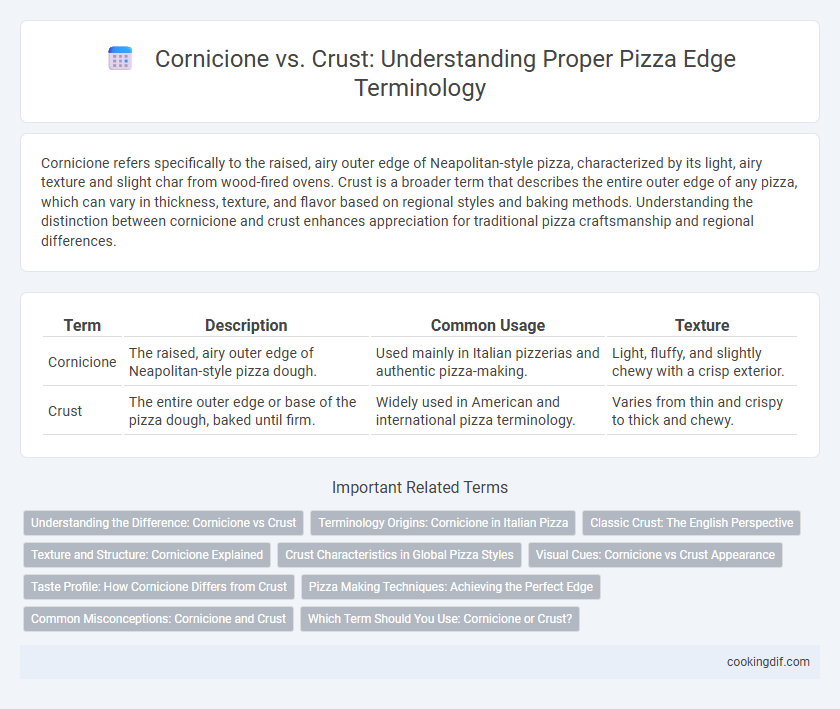Cornicione refers specifically to the raised, airy outer edge of Neapolitan-style pizza, characterized by its light, airy texture and slight char from wood-fired ovens. Crust is a broader term that describes the entire outer edge of any pizza, which can vary in thickness, texture, and flavor based on regional styles and baking methods. Understanding the distinction between cornicione and crust enhances appreciation for traditional pizza craftsmanship and regional differences.
Table of Comparison
| Term | Description | Common Usage | Texture |
|---|---|---|---|
| Cornicione | The raised, airy outer edge of Neapolitan-style pizza dough. | Used mainly in Italian pizzerias and authentic pizza-making. | Light, fluffy, and slightly chewy with a crisp exterior. |
| Crust | The entire outer edge or base of the pizza dough, baked until firm. | Widely used in American and international pizza terminology. | Varies from thin and crispy to thick and chewy. |
Understanding the Difference: Cornicione vs Crust
The cornicione refers specifically to the raised, airy outer edge of Neapolitan-style pizza, characterized by its light, puffy texture due to high hydration dough and steam during baking. In contrast, the crust encompasses the entire outer boundary of the pizza base, including the cornicione, and can vary widely in thickness, crunchiness, and texture depending on regional styles and dough composition. Understanding that the cornicione is a subset of the crust clarifies the distinction, highlighting the artisanal quality of a well-developed cornicione compared to the broader concept of crust.
Terminology Origins: Cornicione in Italian Pizza
The term "cornicione" originates from Italian pizza terminology, specifically describing the raised, airy edge of Neapolitan-style pizzas formed by high hydration dough and wood-fired baking. Unlike the broader English word "crust," which generally refers to the entire outer edge, "cornicione" emphasizes the puffy, textured border that results from natural leavening and oven heat expansion. This distinction highlights the cultural and culinary importance of authentic Italian pizza craftsmanship in defining pizza edges.
Classic Crust: The English Perspective
In the context of Classic Crust pizza, the English perspective often merges the terms cornicione and crust, typically referring to the entire outer edge as the crust. Cornicione specifically describes the raised, airy rim seen in Italian-style pizzas, characterized by its light, chewy texture and golden-brown blisters. English usage generally favors a simpler definition, emphasizing the crust as the baked, sometimes thickened border that holds the pizza toppings, without distinguishing the textural nuances found in traditional Italian cornicione.
Texture and Structure: Cornicione Explained
The cornicione refers to the raised, airy, and crispy edge of a Neapolitan-style pizza, characterized by its light, fluffy texture and slightly charred exterior resulting from high-temperature baking. In contrast, the crust can denote the entire outer edge of a pizza, including both the cornicione and any thinner, denser sections surrounding the base. Understanding cornicione emphasizes the importance of fermentation, dough hydration levels (often around 65-70%), and oven temperature (900degF+/485degC) to achieve its signature airy structure and chewy bite.
Crust Characteristics in Global Pizza Styles
Crust characteristics vary significantly across global pizza styles, influencing texture, flavor, and overall eating experience. Italian Neapolitan pizza features a light, airy cornicione with a soft, chewy crust, whereas New York-style pizza emphasizes a thinner, crispier crust edge without a pronounced cornicione. In contrast, Chicago deep-dish pizza showcases a thick, buttery crust that serves as a substantial base beyond just the edge, highlighting regional preferences in dough density and baking techniques.
Visual Cues: Cornicione vs Crust Appearance
The cornicione is the puffy, raised edge of Neapolitan-style pizza, characterized by its airy, blistered texture and golden-brown spots from high-heat baking. In contrast, the crust refers to the entire outer edge of the pizza, often denser and less pronounced, varying from thin and crispy to thick and chewy depending on regional styles. Visually, the cornicione stands out as a distinct, voluminous rim, whereas the crust may appear flat and uniform around the pizza's perimeter.
Taste Profile: How Cornicione Differs from Crust
The cornicione refers specifically to the airy, puffy outer edge of Neapolitan-style pizza, characterized by a light, tender texture and slightly charred, smoky flavor due to its high-temperature wood-fired baking. The crust, in contrast, broadly encompasses the entire base edge of the pizza, often denser and chewier with a more uniform and less complex taste profile. Cornicione's unique fermentation process and baking method create a flavor that balances subtle sweetness with a savory char, distinguishing it from the more neutral, doughy crust edge found on other pizza styles.
Pizza Making Techniques: Achieving the Perfect Edge
The cornicione refers to the raised, airy edge of a Neapolitan-style pizza, achieved through high-hydration dough and proper fermentation techniques that create a light, bubbly texture. In contrast, the crust encompasses the entire outer boundary of the pizza, including both the cornicione and the base, often varying in thickness and crispiness depending on baking methods. Mastering dough handling, temperature control, and oven environment is essential for developing a well-defined cornicione while ensuring the crust maintains the desired balance of chew and crunch.
Common Misconceptions: Cornicione and Crust
Many pizza enthusiasts confuse cornicione with crust, but cornicione specifically refers to the raised, airy outer edge of a Neapolitan-style pizza, known for its light, bubbly texture. Crust is a broader term encompassing the entire outer boundary of any pizza, including thin, thick, stuffed, or crispy variations. Understanding this distinction clarifies common misconceptions and highlights the unique qualities valued in traditional Italian pizza making.
Which Term Should You Use: Cornicione or Crust?
The term "cornicione" specifically refers to the raised, airy edge of Neapolitan-style pizza known for its light, puffy texture achieved through high hydration dough and rapid oven baking. In contrast, "crust" is a broader term encompassing the entire outer baked edge of any pizza, regardless of style or texture. Use "cornicione" when discussing artisanal or traditional Italian pizza to convey authenticity and dough quality, while "crust" suits general or commercial pizza contexts.
Cornicione vs Crust for edge terminology Infographic

 cookingdif.com
cookingdif.com